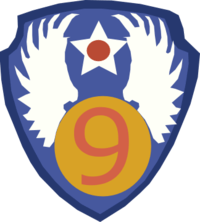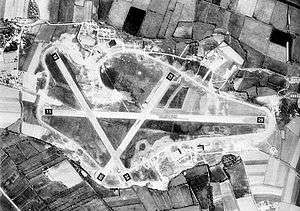RAF Weston Zoyland
| Royal Air Force Station Westonzoyland USAAF Station AAF-447  | |
|---|---|
| Located Near Bridgwater, Somerset, United Kingdom | |
|
Westonzoyland airfield, 22 April 1944. Devoid of aircraft prior to the 442d Troop Carrier Group moving in during June. | |
 Map showing the location of RAF Westonzoyland within Somerset. | |
| Coordinates | 51°06′23″N 002°54′30″W / 51.10639°N 2.90833°W |
| Type | Military airfield |
| Code | ZW |
| Site information | |
| Controlled by |
Royal Air Force United States Army Air Forces |
| Site history | |
| Built | 1925 |
| In use | 1942-1947 |
| Battles/wars |
European Theatre of World War II Air Offensive, Europe July 1942 - May 1945 |
| Garrison information | |
| Garrison |
RAF Transport Command Ninth Air Force |
| Occupants |
No. 525 Squadron 442d Troop Carrier Group |


RAF Westonzoyland is one of the country's oldest airfields being established in the early 1920s. Somerset, England. The airfield is located approximately 4 miles (6.4 km) east-southeast of Bridgwater; about 125 miles (201 km) west-southwest of London
Established in 1925 with summer camps which would last from May until September each year, it was used by both the Royal Air Force and United States Army Air Forces. During the war it was used primarily as an army co-operation airfield but several squadrons were based there with a variety of aircraft. Spitfires, Hurricanes and Mosquito's. Briefly - the early Meteor jets were based before flying off to RAF CULMHEAD in East Devon. There after they were based at RAF MANSTON with the mission of shooting down the V1 rockets. After being stood down in 1947 it was recommissioned in 1952 as a Meteor jet training base as a result of the Korean War. It was home to 209 AFS where Lord Craig and Sir Patrick Hine were based before going to become Air Chief Marshals of the RAF.
Today the remains of the airfield are a mixture of farmland and a base for Civil Air Patrol activities.
History
Westonzoyland airfield originated in the mid-1920s as a landing ground, being in use by 1926 for drogue tugs using the anti-aircraft gunnery range off Watchet in the Bristol Channel. At first, it was no more than an extended cow pasture, subject only to seasonal use until the Second World War loomed, when the site was occupied on a permanent basis. During the pre-war years, buildings were erected piecemeal as required and the landing ground area gradually enlarged but, with the fall of France, Westonzoyland was no longer a backwater airfield.[1]
To obtain the necessary amount of land for siting runways of sufficient length, the A372 to Othery was closed and diverted south on a former minor road.
In 1942, the Air Ministry decided to upgrade the airfield to bomber standard and, early in 1943, work began on laying concrete runways and the perimeter track to the Class A airfield standard, the main feature of which was a set of three converging runways each containing a concrete runway for takeoffs and landings, optimally placed at 60 degree angles to each other in a triangular pattern.[2]
The airfield runways were a main of 5.775 ft at 11/29, and ancillaries of 3,564 ft at 05/23 and 4,101 ft at 16/34. Two hardstands were of 150 ft diameter pans and there were 33 loops connecting to an enclosing perimeter track, of a standard width of 50 feet.[1]
USAAF use
Westonzoyland was known as USAAF Station AAF-447 for security reasons during the war while under American control, and by which it was referred to instead of location. Its Station-ID was "ZW".
442d Troop Carrier Group
There was a long delay before the allocated unit, the 442d Troop Carrier Group arrived after D-Day from RAF Fulbeck. Its operational squadrons were:
- 303d Troop Carrier Squadron (J7)
- 304th Troop Carrier Squadron (V4)
- 305th Troop Carrier Squadron (4J)
- 306th Troop Carrier Squadron (7H)
The 442d was a group of Ninth Air Force's 50th Troop Carrier Wing, IX Troop Carrier Command. The group moved in October 1944 to its Advanced Landing Ground (ALG) Peray Airfield (ALG A-44) France.
Subsequent RAF use
The station had never been officially transferred from the RAF and the anti-aircraft support units were quick to return. Several Squadrons were based at Westonzoyland, but the longest stay was by No. 16 Squadron RAF who flew Westland Lysanders,[3] and later with the North American Mustang. Later Supermarine Spitfires became a common sight being flown by No. 19 Squadron RAF and others.[1] Nos. 286 and 587 Squadrons with their mixture of Miles Martinets, Hawker Hurricanes, Airspeed Oxfords, Vultee A-31 Vengeances and North American Harvards remained in residence until near the end of hostilities.[1] 587 Squadron was formed at RAF Westonzoyland, on 1 December 1943, from 1600 Flight, 1601 Flight and 1625 Flight for anti-aircraft co-operation duties over Wales and the south east of England. It operated a variety of aircraft in this role. Due to the ongoing training requirement the squadron was not disbanded at the end of the war and it moved to RAF Tangmere on 1 June 1946 to cover the south coast, but was disbanded shortly afterwards on the 15 June 1946.[4]
Four fighter squadrons came and departed during the months following the end of the war in Europe, but by 1947 the station was reduced to care and maintenance.[1]
There was virtually no further flying at Westonzoyland until the summer of 1952 when, to meet the Soviet threat, an increase in the RAF's strength and a demand for more aircrews found Meteors and Vampires operating in a training role.
English Electric Canberra squadrons were present during the mid-1950s when Westonzoyland was used as a work-up station prior to overseas assignments. By 1958 the station was once more deserted of aircraft and, although retained by the Air Ministry for another ten years, it never reopened for military flying. Some of these Canberras flew out to Australia to take part in the British atomic tests at Maralinga.
Current use

Upon its release from military use, in the 1960s, the A372 was restored to near its original route by utilizing a considerable length of the former main runway.[1] The former secondary runways are clearly evident in aerial photography, although most of the concrete has been removed. The former perimeter track has been reduced to a single-lane agricultural road with the pan and loop dispersal hardstands all being removed. Several derelict buildings still remain, including the control tower and a large cluster to the northwest of the perimeter, including the base of what appears to be the remains of two large J-Type hangars and a support site. No evidence of the Pierced Steel Planking extensions to the runways remain nor of an ammunition dump.
In the late 1960s, local people used the base's squash courts.
Although much of the airfield is no longer usable for aviation purposes, Westonzoyland Airfield is in use for Microlights which uses the northwest half of the 16/34 runway, and is a base for the Sky Watch Civil Air Patrol (SWCAP).
See also
References
![]() This article incorporates public domain material from the Air Force Historical Research Agency website http://www.afhra.af.mil/.
This article incorporates public domain material from the Air Force Historical Research Agency website http://www.afhra.af.mil/.
Citations
- 1 2 3 4 5 6 Berryman, David (2006). Somerset airfields in the Second World War. Newbury: Countryside Books. pp. 142–158. ISBN 1-85306-864-0.
- ↑ "Westonzoyland airfield". English Heritage. Retrieved 5 September 2010.
- ↑ "Westland Lysander". History of War web site. J Rickard. 2007. Retrieved 2009-05-17.
- ↑ Halley, James J. The Squadrons of the Royal Air Force & Commonwealth, 1918-1988. Tonbridge, Kent, UK: Air-Britain (historians) Ltd., 1988. ISBN 0-85130-164-9. page 414
Bibliography
- Freeman, Roger A. (1994) UK Airfields of the Ninth: Then and Now 1994. After the Battle ISBN 0-900913-80-0
- Maurer, Maurer (1983). Air Force Combat Units Of World War II. Maxwell AFB, Alabama: Office of Air Force History. ISBN 0-89201-092-4.
External links
| Wikimedia Commons has media related to RAF Weston Zoyland. |


.svg.png)